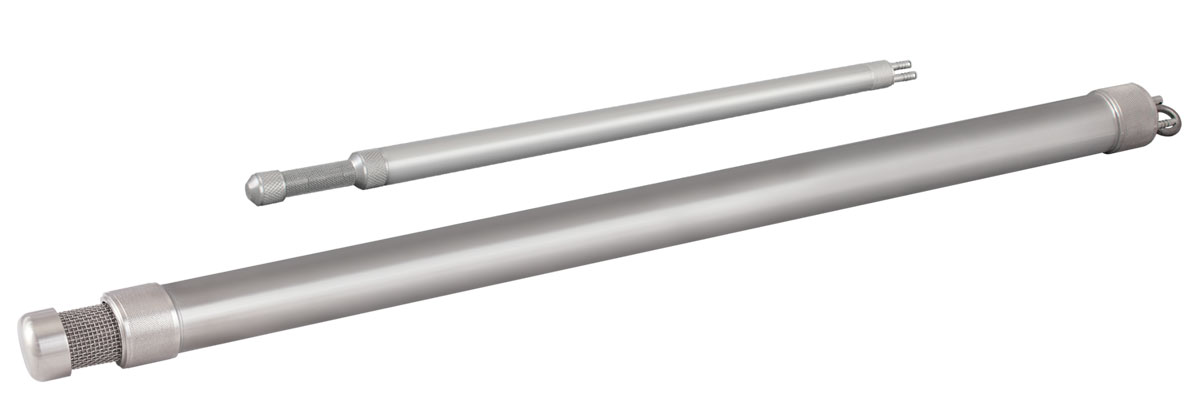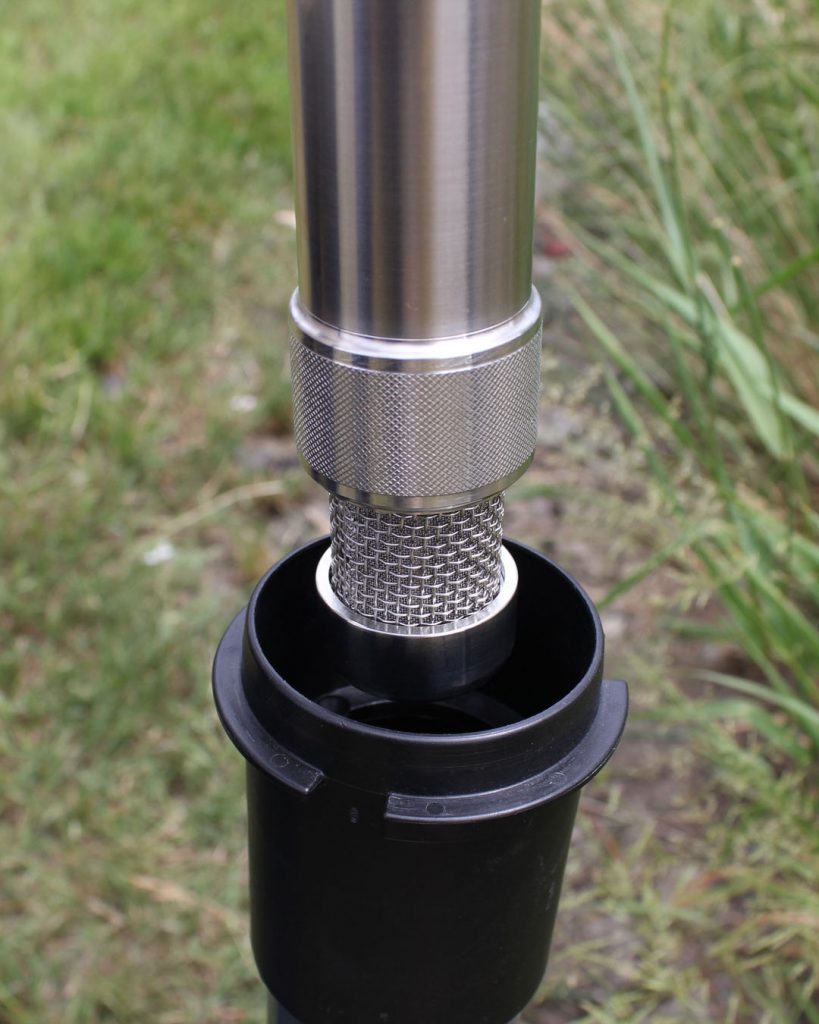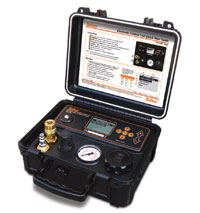Solinst Double Valve Pumps
Double Valve Pumps can provide high quality, representative groundwater samples. However, to get the best quality samples from your pump, it is critical to understand how the Double Valve Pump works and how to operate it properly.

Solinst 1.66″ and 5/8″ Stainless Steel Double Valve Pumps
Double Valve Pump Operating Principles
When a Double Valve Pump is submerged, hydrostatic pressure forces water through the filter intake in the base of the pump, filling the pump body and both the drive and sample lines to static level.
Pressure is applied to the drive line using a compressed air source and a pump control unit. During the drive period on the control unit, the pressure pushes down on the water column in the drive line, which forces the water in the pump up the sample line. A check valve at the bottom of the pump closes to prevent water from exiting the pump during the drive period.
After the drive period, the pump control unit switches to vent, and pressure is released. New formation water flows into the pump and drive line, while a check valve at the top of the pump closes to prevent water from draining back down the sample line.
After venting, pressure is re-applied, again forcing water from the pump and raising the water in the sample line closer to the surface. Repeating the drive and vent cycle will eventually cause the water in the sample line to discharge at surface in a gentle pulsating flow.
See the Double Valve Pump Operating Principles document for a detailed illustration of the Double Valve Pump operation, or check out the video below.
Optimizing Pressure
The key to a representative sample, especially when monitoring for volatiles, is to not allow drive gas to enter the pump and aerate the sample water during a drive period. This means you need to carefully calculate the appropriate amount of pressure to be applied. Always calculate pressure based on depth to static water level (plus 10 psi for line loss), increasing only incrementally to improve performance.
The pressure needed is calculated based on the fact that it takes about 1 psi of pressure to raise 2.3 ft. of water. To calculate pressure needed in psi, take depth to static level in feet, and multiply by 0.43 psi/ft. (1 psi / 2.3 feet = 0.43 psi/ft.). E.g., if depth to static water level is 50 ft., the pressure needed is calculated by the following:
50 ft. to static level x 0.43 psi/ft. + 10 psi = 32 psi needed.
Helpful Hints
Drive Gas Recommendations
For applications to depths of 100 ft (30 m) or less, a Solinst 12 Volt Compressor is an excellent option. For deeper applications, a larger compressor should be used. When selecting a compressor, keep in mind that it takes about 1 CFM (Cubic Feet per Minute) to deliver 1 US Gallon per Minute (~4000 ml/min) at 0 psi.
Typically, an air compressor with a 4 to 5 CFM capacity will provide and maintain an output pressure of 100 psi. An oil-less compressor should always be used.
For deeper sampling, a compressed air cylinder with a regulator is also an option. To get a representative sample, you may want to consider using nitrogen instead of air as your compressed gas source. A nitrogen cylinder is ideal as it is an inert, dry gas. It takes about 10 L of compressed gas to supply 1 L of sample water.
Pump Control Units
With the proper pump control unit, Double Valve Pumps can achieve high purge rates, as well as low flow sampling rates. A control unit with preset flow rates, as well as the ability to adjust the drive/vent cycle is an advantage to ensure you get the optimal sampling rate for your application.
For help determining the proper drive and vent times, see our document Sampling Groundwater Using Bladder Pumps and Double Valve Pumps.
Pumping Depth
Because you need a column of water in the drive line to push down on, to circulate water through the pump and up the sample line, the higher the water column present in the drive line – the better. A large water column makes the pump more efficient and less likely to over pressurize the system and allow air to enter the pump body. Having the pump submerged a minimum of a few meters below static water level is strongly recommended.
Note: If using a Double Valve Pump on a tubing reel, the Solinst Power Winder is a great option to add for efficiently and effortlessly lowering the pump to greater depths.
Well Recovery Rate
Having more than a few meters of water in the drive line is also helpful in situations where you know your well is slow to recover. This helps prevent drive gas from entering the pump if your well has not fully recovered to static level before the next drive period. Knowing how quickly your well recovers, also helps you time your drive/vent cycles properly.
Purging
If you are concerned about water from different levels mixing while the pump is being lowered, purging the pump a few times when the pump is at its desired sampling depth will eliminate any chemistry from other levels.

408 Double Valve Pumps are positive displacement, gas drive pumps providing high quality, consistent samples, and excellent VOC sample results. Pumps are available in stainless steel 5/8″ diameter and 1.66″ diameter, as well as in PVC 1.66″ diameter. Portable or dedicated versions are available. They can be fitted with packers to control groundwater flow and limit purge requirements. DVPs are easily disassembled for decontamination in minutes, without any tools.
Get a Quote!

